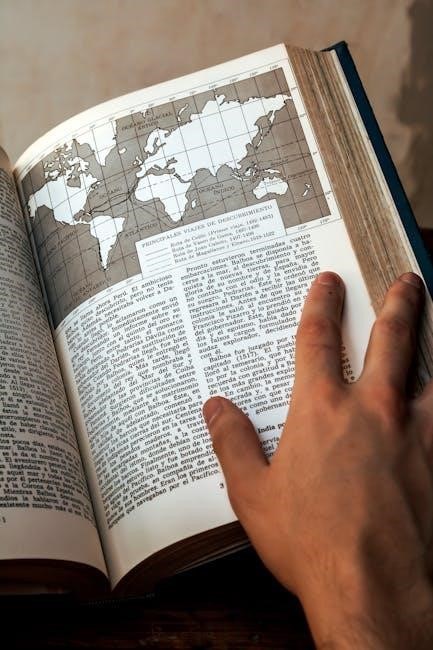ap world history unit 1 study guide
This guide covers developments from c. 1200 to c. 1450, focusing on East Asia, Afro-Eurasia, and the Americas. It explores empires, trade, religion, and cultural exchange.
This period, spanning the 13th to the 15th century, highlights the interconnectedness of societies across Afro-Eurasia and the Americas. Key themes include the rise and fall of empires, religious influences, and cultural exchanges. The Song Dynasty in China, the Islamic Golden Age, and the Mongol Empire’s expansion are central focuses. Trade networks, such as the Silk Road, facilitated the spread of goods, ideas, and technologies, while regional diversity and innovation shaped the global tapestry during these transformative centuries.
1.2 Key Themes and Learning Objectives
Key themes include state formation, cultural exchange, and the impact of trade networks. Learning objectives focus on analyzing primary sources, evaluating historical developments, and understanding the interconnectedness of societies. Students will explore how empires rose and fell, religions influenced cultures, and technologies transformed societies. The period highlights the diversity and complexity of global interactions, preparing students to synthesize historical patterns and their legacies in shaping the modern world.

Developments in East Asia (c. 1200 to c. 1450)
East Asia saw cultural and economic advancements under the Song Dynasty, while the Yuan Dynasty brought Mongol influence, shaping the region’s political and social landscapes from 1200 to 1450.
2.1 Significance of the Song Dynasty (960-1279)
The Song Dynasty marked a golden age in Chinese history, characterized by economic prosperity, cultural advancements, and intellectual innovations. It witnessed the rise of urban centers, technological progress, and a robust education system. The dynasty’s emphasis on Neo-Confucian principles shaped societal values, while advancements in agriculture, industry, and maritime trade strengthened its economy. The Song also established a sophisticated administrative system, including the civil service exam, which became a model for future dynasties. Its legacy endured long after its fall in 1279.
2.2 Government Systems in Chinese Dynasties
Chinese dynasties utilized centralized bureaucratic systems, with the emperor holding supreme power. The Song Dynasty perfected the civil service exam, ensuring merit-based appointments. This system emphasized Confucian ideals, fostering loyalty and competence among officials. Local governments operated under central authority, maintaining administrative efficiency. The Mongol invasion later introduced elements of military rule, blending with existing bureaucratic structures. Over time, these systems evolved, adapting to changing political and social dynamics while retaining core principles of centralized governance and Confucian influence;
2.3 Cultural and Intellectual Innovations in China
During the Song Dynasty, China experienced a cultural and intellectual renaissance. Advances in literature, poetry, and painting flourished, with scholars emphasizing classical texts. The invention of movable-type printing and gunpowder highlighted technological ingenuity. Education systems expanded, fostering intellectual discourse and the rise of Neo-Confucianism, blending Confucianism with Buddhism and Daoism. These innovations not only enriched Chinese society but also influenced neighboring regions, showcasing China’s enduring legacy as a hub of cultural and intellectual advancement during this period.
Empires and States in Afro-Eurasia
Afro-Eurasia saw the rise of powerful empires and states, with the Islamic world playing a central role in trade, culture, and intellectual exchange, shaping global connections.
3.1 The Islamic World: Abbasid and Mongol Influences
The Islamic world flourished under the Abbasid Caliphate, fostering intellectual and cultural advancements. However, the Mongol invasions disrupted this stability, leading to the decline of Abbasid power. Despite this, Islamic states adapted, blending traditions with Mongol influences. Trade and cultural exchange thrived, spreading Islamic ideas across Afro-Eurasia. The legacy of Abbasid intellectual contributions and Mongol administrative systems shaped the region’s political and cultural landscape, emphasizing resilience and syncretism in the face of significant upheaval.
3.2 The Rise of Islamic States and Intellectual Innovations
The Islamic world saw the emergence of powerful states like the Seljuk and Mamluk dynasties, which preserved and expanded Abbasid knowledge. Scholars made groundbreaking advancements in mathematics, astronomy, and medicine, with figures like Al-Khwarizmi and Ibn Sina leaving lasting legacies. Islamic intellectual centers, such as Baghdad and Cairo, became hubs for learning, attracting scholars from diverse backgrounds. These innovations not only enriched Islamic civilization but also influenced global intellectual traditions, fostering a golden age of discovery and cultural exchange;
3.3 Trade Networks and Their Impact on Afro-Eurasia
Extensive trade networks, including the Silk Road and maritime routes, connected Afro-Eurasia, facilitating the exchange of goods, ideas, and technologies. Merchants traded spices, textiles, and metals, while the spread of religions like Buddhism, Christianity, and Islam was enhanced. These networks also spurred cultural diffusion, with techniques like papermaking and gunpowder spreading from China. The Mongol Empire’s unification of vast territories further intensified trade, creating a prosperous and interconnected Afro-Eurasian economy that laid the foundation for global commerce and cultural exchange.

Developments in South and Southeast Asia
Explores the rise of key empires in South and Southeast Asia, regional trade, religious influences, and cultural advancements during the period c. 1200-1450.
4.1 The Delhi Sultanate and the Vijayanagara Empire
The Delhi Sultanate, established in 1206, centralized power in North India, implementing administrative reforms and military strategies. The Vijayanagara Empire, rising in the 14th century, became a major South Indian power, fostering Hindu traditions and resisting Muslim rule. Both empires showcased unique political systems, cultural blending, and religious influences. Their rule shaped regional identities, trade networks, and artistic advancements, leaving lasting legacies in South Asia.
4.2 The Majapahit Empire and Its Legacy
The Majapahit Empire, rising in the 13th century, became a dominant power in Southeast Asia. Under rulers like Gajah Mada, it expanded territorially and culturally, blending Hindu-Buddhist traditions. Its decline by the 15th century coincided with the rise of Islamic states. Majapahit’s legacy includes advancements in art, literature, and governance, shaping regional identity and cultural practices in modern Indonesia and beyond. Its influence remains visible in historical narratives and cultural symbols of Southeast Asia today.
4.3 Religious and Cultural Transformations in South Asia
Bhakti movements emerged in South Asia, emphasizing personal devotion and challenging caste hierarchies. Islam’s influence expanded through Sufism, fostering cultural exchange with local traditions. This period saw the construction of iconic temples and mosques, blending regional architectural styles. The coexistence of Hinduism and Islam enriched cultural practices, while the Vijayanagara Empire patronized arts, leaving a lasting legacy in South Asia’s cultural identity.
The Americas Before Columbus
The Americas saw advanced civilizations like the Aztecs and Incas, who built centralized states, harnessed agriculture, and developed intricate trade networks and architectural achievements.
5.1 The Aztec and Inca Empires
The Aztec Empire, centered in Tenochtitlán, was a militaristic state with advanced infrastructure like aqueducts and pyramids. The Inca Empire, spanning the Andes, relied on road networks and terraced farming. Both empires had complex administrative systems, with the Incas using quipus for record-keeping. Religion played a central role in Aztec society, while the Incas emphasized imperial loyalty and agricultural productivity. These civilizations showcased remarkable engineering and organizational skills.
5.2 Political, Social, and Economic Structures in the Americas
In the Americas, pre-Columbian societies like the Aztecs and Incas had hierarchical structures. The Aztecs operated under a theocratic system, while the Incas used a decentralized administrative model. Socially, both empires had distinct classes, with elites controlling resources. Economically, they relied on agriculture, with systems like chinampas in Aztec society and terraced farming in Inca regions. Trade networks and tribute systems were integral to their economies, sustaining their complex civilizations before European contact.
5;3 Indigenous Cultures and Their Contributions
Indigenous cultures in the Americas made significant contributions to agriculture, medicine, and architecture. The Aztecs developed advanced irrigation systems, while the Incas built terraced farms. Both civilizations excelled in mathematics and astronomy, creating sophisticated calendars. Their knowledge of medicinal plants and surgical techniques was unparalleled. Artisanal crafts, such as textiles and pottery, flourished, reflecting their cultural richness. These innovations not only sustained their societies but also left a lasting legacy in the modern world, showcasing their ingenuity and creativity.

Trade and Cultural Exchange
Trade and Cultural Exchange involves the exchange of goods, ideas, and technologies across vast networks like the Silk Road and maritime routes, fostering cultural diversity and innovation.
6.1 The Silk Road and Maritime Trade
The Silk Road and maritime trade networks connected East Asia, the Islamic World, Africa, and Europe, facilitating the exchange of goods like silk, spices, and porcelain. These routes also enabled the spread of ideas, religions, and technologies, such as Buddhism, Islam, and Chinese innovations like the compass and gunpowder. Merchants and traders played pivotal roles in these exchanges, fostering cultural and economic ties across vast regions and shaping the global economy during this period.
6.2 Spread of Ideas, Technologies, and Religions
The exchange of ideas, technologies, and religions flourished along trade routes. Buddhism spread from India to China and Japan, while Islam expanded across Afro-Eurasia. Technological advancements like the compass, gunpowder, and printing press disseminated widely. These exchanges fostered cultural blending, such as the synthesis of Buddhist and local traditions in Southeast Asia. Religious and intellectual movements, including Neo-Confucianism, also gained traction, shaping societies and fostering a period of cultural and scientific growth.
6.3 The Role of Merchants and Missionaries
Merchants and missionaries played pivotal roles in facilitating cultural and religious exchange. Merchants traded goods, ideas, and technologies, bridging distant regions. Missionaries, such as Buddhist monks and Christian priests, spread their faiths, adapting to local cultures. Islamic scholars and traders disseminated knowledge and practices across Afro-Eurasia. These individuals acted as cultural ambassadors, fostering understanding and syncretism while sometimes facing resistance. Their activities were central to the global tapestry of interconnectedness during this period.

The Role of Religion
Religion shaped societies, influencing culture, politics, and daily life. Buddhism, Christianity, and Islam spread widely, fostering syncretism and sometimes conflict. States often aligned with religions for legitimacy.
7.1 Buddhism, Christianity, and Islam
Buddhism, Christianity, and Islam were central to shaping societies. Buddhism emphasized enlightenment and non-violence, spreading through trade and missionary efforts. Christianity, centered on Jesus’ teachings, became a unifying force in Europe. Islam, founded on Muhammad’s revelations, expanded rapidly across Afro-Eurasia, fostering cultural and intellectual advancements. These religions influenced art, law, and daily life, often intertwining with state power to legitimize rulers and create cohesive communities. Their diffusion via trade networks and missionary work connected distant regions, fostering cultural exchange and religious diversity.
7.2 Syncretism and Religious Conflicts
Religious blending, or syncretism, occurred as faiths intersected, creating hybrid practices. Buddhism merged with local traditions in East Asia, while Islam incorporated African and Southeast Asian customs. However, religious conflicts also arose, such as the Crusades between Christians and Muslims. The Mongol Empire’s expansion forced religious coexistence, yet tensions persisted. Persecution of minorities, like Jews in Europe, highlighted religious intolerance. These dynamics shaped societal cohesion and division, influencing cultural and political landscapes across Afro-Eurasia.
7.3 Religion and State Formation
Religion played a central role in state formation, often legitimizing rulers and shaping governance. In the Islamic world, caliphs derived authority from religious leadership, while in Hindu and Buddhist societies, kings were seen as divine or moral guardians. The Delhi Sultanate and Vijayanagara Empire aligned their rule with religious traditions to consolidate power. Similarly, the Mongols used religious tolerance to unify diverse populations. This interplay between religion and politics strengthened state structures and fostered societal cohesion across Afro-Eurasia.

The Mongol Empire
The Mongol Empire, established by Genghis Khan, expanded vastly across Eurasia, known for military prowess, administrative systems, and cultural tolerance, significantly impacting trade and history.
8.1 Rise and Expansion of the Mongol Empire
The Mongol Empire began with Genghis Khan, who unified Mongol tribes in 1206. His military strategies and leadership enabled rapid expansion. By 1227, the empire stretched from China to Eastern Europe. Under successors like Ögedei and Kublai Khan, the Mongols conquered vast territories, creating the largest contiguous empire in history. Their success stemmed from military organization, merit-based promotions, and adaptability. This expansion facilitated trade, cultural exchange, and the spread of ideas across Eurasia, shaping global history profoundly.
8.2 The Impact of Mongol Rule on Eurasia
The Mongol Empire facilitated trade and cultural exchange through the Silk Road, fostering economic growth. Their tolerant policies allowed religions like Buddhism, Christianity, and Islam to coexist. The Mongols established a unified administrative system, promoting stability. However, their conquests caused widespread destruction and population decline. The spread of ideas, technologies, and diseases also occurred due to increased connectivity. Overall, Mongol rule reshaped Eurasia’s political, economic, and cultural landscapes, leaving a lasting legacy in global history and interregional relations.
8.3 Legacy of the Mongol Empire
The Mongol Empire’s legacy includes the establishment of khanates that influenced regional governance and culture. Their tolerance for diverse religions promoted cultural exchange. Control of the Silk Road enhanced trade, fostering the exchange of goods, ideas, and technologies across vast regions. While initial conquests caused destruction and population decline, the Mongols’ administrative systems and military innovations left a lasting impact on Eurasia. The Yuan Dynasty in China and the Golden Horde in Russia exemplify their enduring influence on political and cultural landscapes.

Study Tips and Strategies
Focus on key themes, organize study materials thematically, and practice essay prompts. Regularly review timelines and causation to enhance understanding and retention of historical developments.
9.1 How to Approach the AP Exam
To excel in the AP World History exam, focus on understanding the format and content. Allocate time effectively for multiple-choice questions, short answers, and essays. Practice analyzing primary sources and historical causation. Review key themes like empires, trade, and cultural exchange. Utilize past exam questions to refine your essay-writing skills. Stay organized with timelines and concept maps to visualize historical developments. Regularly test yourself on key terms and concepts to build confidence and clarity.
9.2 Key Terms and Concepts to Remember
Mastering key terms is essential for success in AP World History. Focus on concepts like the Silk Road, Mongol Empire, Song Dynasty, and Islamic Golden Age. Understand terms such as syncretism, feudalism, and mercantilism. Key technologies include the compass, gunpowder, and printing press. Study religious influences like Buddhism, Christianity, and Islam. Review state-building strategies and trade networks. Familiarize yourself with historical developments, cultural exchanges, and major empires. These concepts are crucial for analyzing historical patterns and themes effectively.
9.3 Effective Use of Study Resources
Efficiently utilizing study resources is vital for success. Prioritize textbooks, online guides, and practice exams to reinforce learning. Use flashcards for key terms and concept maps to visualize connections. Engage with study groups to discuss complex topics. Regularly review notes and summaries to retain information. Explore reputable websites and educational platforms for additional insights. Balance study time with breaks to maintain focus. Consistently practice essay-writing and multiple-choice questions to master exam formats. Active learning and resource management will enhance your preparation and confidence.


